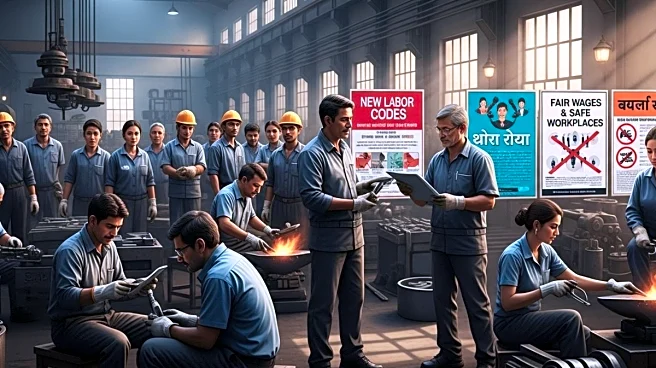Labour reforms in developing nations have played a crucial role in fostering inclusive growth and formal employment. It has been particularly evident in countries such as Vietnam, Indonesia, and Brazil, where the 2019 Labour Code, 2020 Omnibus Law, and 2017 Labour Reform, respectively, have modernised labour markets, attracted investment, and enhanced productivity (World Bank, 2023; OECD, 2022; ILO, 2021). The 2019 labour amendments in Mexico enhanced trade compliance and elevated worker rights (IMF, 2022). Collectively, these reforms demonstrate that well-structured labour policies in developing economies can enhance competitiveness, promote formalisation, and ensure equitable growth, objectives that align closely with India’s current reform trajectory.
As India approaches 2026, on the verge of becoming one of the world’s fastest-growing major economies, the momentum for comprehensive labour market reform has become increasingly vital. The Labour Codes, enacted between 2019 and 2020, are central to this transformation, designed to build a modern, transparent, and equitable labour ecosystem. By consolidating 29 fragmented and outdated laws into four coherent frameworks, the Code on Wages (2019), Social Security Code (2020), Industrial Relations Code (2020), and Occupational Safety, Health and Working Conditions (OSHWC) Code (2020). India aims to simplify compliance, promote formalisation, and strengthen worker protection (Ministry of Labour & Employment, 2020).
This comprehensive overhaul is a legal and economic necessity, addressing structural challenges such as informal employment and inadequate social security coverage. These reforms seek to create a more efficient and business-friendly environment by improving compliance mechanisms and expanding labour rights while upholding worker welfare.
According to the Economic Survey 2024-25, India’s projected 6.4% real GDP growth for FY25 underscores the crucial role of these reforms in enhancing resilience and productivity. In a labour market where over 90% of workers remain in the unorganised sector (Press Information Bureau Release, 2025), the New Labour Codes represent not merely administrative changes, but a paradigm shift towards inclusive and sustainable growth. As implementation advances, these reforms are poised to serve as a cornerstone of India’s journey toward a $5 trillion economy by 2027, balancing efficiency, equity, and long-term development.
Strengthening Worker Prosperity and Economic Demand
The Code on Wages establishes a universal minimum wage framework, incorporating a national floor wage and mandatory periodic reviews every five years to ensure alignment with economic conditions. Mandating timely wage payments without ceilings enhances financial stability for millions, particularly in the unorganised sector. Increased purchasing power stimulates consumer demand, a cornerstone of India’s services-led economy. In rural regions, standardised wages enable workers to invest in education and healthcare, fostering local economic dynamism and supporting domestic market growth.
Expanding Social Security for Inclusive Growth
The Code on Social Security extends comprehensive benefits, health insurance, pensions, and extended maternity leave (12 to 26 weeks) to unorganised, gig, and platform workers through dedicated funds and a national database. The e-Shram portal’s registration of over 30 crore workers by 2024 exemplifies the government’s commitment to formalising the informal sector, creating a robust safety net that reduces economic vulnerabilities. In urban hubs, gig workers in platform-based services can access pensions and health benefits, enhancing economic resilience and workforce participation. It leads to formalisation, which expands the tax base, enabling government investments in infrastructure and skilling, and further fuels economic growth. Aggregation will enormously benefit the platform workers.
Fostering Industrial Harmony and Workforce Adaptability
The Industrial Relations Code promotes industrial harmony through structured mechanisms, including negotiating unions and grievance redressal committees in establishments with 20 or more workers. The code ensures workforce adaptability in a rapidly evolving economy by streamlining dispute resolution and introducing re-skilling funds for retrenched workers. In manufacturing centres, these provisions minimise disruptions, enhancing operational efficiency. Such measures drive productivity and quality job creation, aligning with India’s vision of leveraging its youthful demographic dividend.
Uplifting Workplace Standards and Productivity
The OSHWC Code enhances workplace standards by implementing mandatory free health checkups and establishing a National Occupational Safety and Health Advisory Board. These initiatives mitigate occupational hazards, reducing healthcare costs and absenteeism. In textile hubs, safer workplaces and enhanced facilities, such as canteens, will boost worker morale and productivity for establishments with more than 100 workers. Furthermore, a study also highlights that these improvements yield measurable economic benefits, as healthier workers contribute to higher output across various industries.
Sectoral Transformation for Economic Dynamism
The Labour Codes are expected to act as a growth engine across key sectors, fostering sustainable and inclusive development. In the manufacturing sector, streamlining compliance through unified licenses and digitised records is projected to enhance ease of doing business and attract greater foreign direct investment (FDI). This momentum is likely to strengthen production capabilities and export competitiveness. Moreover, the proposed higher threshold for layoffs (300 workers) will provide industries greater operational flexibility, driving expansion and job creation. In the services and gig economy sectors, extending social security and wage protections for gig workers encourages participation in platform-based jobs, thereby bolstering India’s IT and services sector and contributing significantly to GDP. In agriculture, securing social safety nets for rural workers improves financial stability, enhances productivity within agrarian value chains, and supports rural economies. In Textiles, enhanced safety standards and increased participation of women in the workforce, supported by provisions for safe night shifts, are set to boost export potential and create more rural employment opportunities.
Macroeconomic Implications and Global Competitiveness
The Labour Codes boost economic growth by fostering a more formal, skilled, and productive workforce. Universalising wages and social security ensures financial stability and health protection for all workers, thereby increasing labour productivity and domestic consumption. Formalisation of labour, through mandatory appointment letters and fixed-term employment, attracts investment and reduces informal employment, strengthening the industrial base. Skill development and the National Career Service portal enhance employability and entrepreneurial capacity, creating a dynamic and flexible labour market. Measures promoting female labour force participation expand the workforce, increasing household incomes and economic output. Simplification of compliance and ease of doing business, combined with labour market flexibility, decriminalisation, and technology-driven grievance redressal, reduces procedural bottlenecks, enhancing the system’s ease and simplicity, encouraging entrepreneurship, and improving the investment climate. These reforms create an inclusive, transparent, efficient labour ecosystem that drives sustainable economic growth. Moreover, aligning with international labour standards, the codes enhance India’s global competitiveness, attracting investment and positioning the nation as a hub for manufacturing and services. The government’s harmonisation efforts, such as regional meetings, ensure uniform implementation and foster cohesive economic development.
Summation: A Vision for Inclusive Prosperity
The Labour Codes represent a transformative milestone in India’s economic development trajectory. By empowering workers through equitable wage structures, comprehensive social security coverage, and enhanced occupational safety standards, while simultaneously providing enterprises with streamlined compliance and greater operational flexibility, these reforms establish a synergistic framework conducive to sustainable growth. However, the urgency of labour codes’ implementation cannot be overstated. Prolonged delays in notification and enforcement risk eroding reform momentum and diminishing the potential demographic and economic dividends. In an era marked by rapid technological transformation, evolving global value chains, and post-pandemic shifts in labour market dynamics, the timely execution of these Codes has become an economic imperative rather than a policy option. To fully realise their intended outcomes and support India’s vision of inclusive and resilient development, the Labour Codes must be implemented expeditiously. Supported by complementary initiatives such as the e-Shram portal and the harmonisation of state-level regulations, prompt operationalisation will enable India to leverage its demographic dividend, attract sustainable investment, and strengthen its global competitiveness, thereby advancing the national aspiration of Viksit Bharat@2047.
The author is National Vice President, All India Manufacturers’ Organisation. Views expressed in the above piece are personal and solely those of the author. They do not necessarily reflect News18’s views.












/images/ppid_59c68470-image-176344002585169163.webp)



